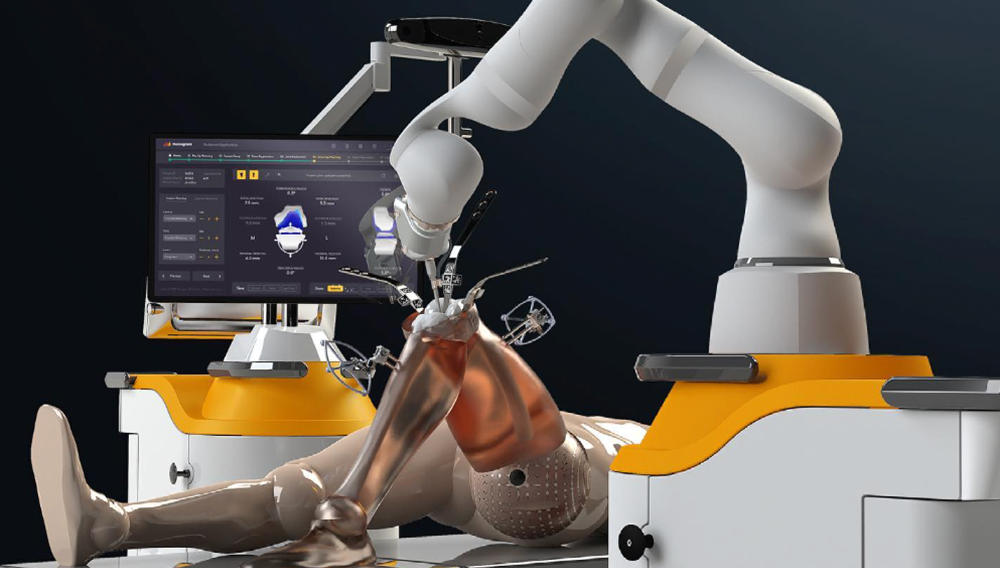
The recent Monogram Orthopedics telesurgery demonstration, in which a surgeon was able to operate on a model from 2,700 km (1,700 miles) away, was a remarkable showcase of the potential for remote surgical procedures. With remote access to expert surgeons, patients benefit from the collective knowledge and experience of specialists who may not be available locally. This access to top-notch surgical expertise can significantly improve the success rates of complex procedures, reducing complications and enhancing the overall quality of care provided.
Yet challenges remain before we see the widespread adoption of telesurgery. In particular, telesurgery requires highly-reliable, low-latency, and secure data exchange in order to make this type of procedure practical in the future. But before we talk about the technology specifics, let’s first consider why this technology is necessary for helping people. It may not be immediately obvious, especially for those living in areas with good on-premise access to quality healthcare. Yet the stark reality is that in many areas of the world, access to a surgeon may be limited or even non-existent.
Telesurgery's most significant contribution lies in its potential to democratize access to highly-skilled surgical procedures. Traditionally, world-class surgeons and specialized medical facilities have been concentrated in urban centers, leaving those in rural and remote areas at a disadvantage. Telesurgery bridges this gap by enabling patients in underserved regions to access the expertise of top-tier surgeons in rapid-response environments without the need for long-distance travel. And the benefit of enabling specialized facilities to provide remote care cannot be overstated, especially in emergency situations such as remote stroke treatment.
Providing a platform for telesurgery can also facilitate remote collaboration and training among healthcare professionals. Surgeons can consult with colleagues and experts in real-time, irrespective of their physical location. This knowledge-sharing serves as a valuable tool for training the next generation of surgeons, enabling them to learn from experienced mentors without the need for physical proximity.
So what capabilities are needed to move forward? To succeed, telesurgery needs Artificial Intelligence (AI) and reliable, low-latency communication over long distances. Both of these are really hard problems.
Some level of autonomy in the robot surgeon is needed to manage the latency and jitter, as well as respond to unexpected changes in the local environment. Look at this example to see how it could work in practice. Here, the RMC MiroLabs system automatically accounts for movement and changes in the beating heart, while taking none of the decision-making power away from the surgeon. Artificial intelligence can fill in any gaps between the intent of the surgeon- who executes the operation as if the heart is stationary, and the live movement of the heart. With the right level of automation and application of AI, the telesurgery option has the potential to expand the benefits of robotic surgery for a variety of clinical procedures and remote care environments.
For telesurgery to be practical, it needs to operate over existing public networks. Remote surgical systems that require a dedicated, low-latency network will limit the operating area to dense urban areas. This is not the realm where telesurgery can have the greatest impact. Public networks are improving all the time in terms of reliability and performance, but they are still, and will continue to be, very dynamic with variable levels of performance. The differentiator is clear: The more uncertainty your system can deal with, the wider the application and adoption of telesurgery can be, and especially in remote areas. The physical layer of the network must therefore offer sufficient performance as a starting point. But the networking technology that teleoperation is based on must also be able to optimize communication to achieve the best latency possible with any given network, thus increasing its practical use. Surgeons must also be able to trust that the network will maintain a consistent level of performance throughout the procedure. Dropped connections can lead to catastrophic outcomes. At a holistic level, reliability must extend beyond the network – it must encompass the entire ecosystem of hardware and software, from the robotic surgical instruments down to the data transmission protocols.
To solve all of these challenges, a system architecture built around highly-reliable communication is the key. This is where RTI comes in. RTI Connext® gives developers and architects the solution to these most fundamental challenges. Connext was designed to solve the challenges of autonomous and semi-autonomous robotics. With its additional support for public Wide-Area Networks (WAN), Connext provides architects with reliable connections across any network, with the unique ability to maintain reliable connections over unreliable networks. In addition, RTI Tools such as Cloud Discovery provide a holistic, failure-tolerant architecture that is purpose-built to meet the needs of surgical robotics.
It’s encouraging to see the innovation that Monogram Orthopedics and others have achieved and to see the industry addressing the inherent network challenge in telesurgery. To achieve widespread adoption and ensure surgical success, we must address the complexities of latency, reliability, security, and seamless integration in the ever-changing landscape of networks. As we continue to push the boundaries of medical technology, it is crucial to remember that the success of telesurgery ultimately depends on our ability to conquer these challenges, providing surgeons with the tools they need to save lives, even from a distance.
About the author:
 Bob Leigh, Senior Director of Commercial Markets, RTI
Bob Leigh, Senior Director of Commercial Markets, RTI
Bob has been matching market needs and emerging technology for over 20 years as an entrepreneur and technology leader. He has spent his career in small companies and is the founder of two. At each venture he led the charge to create new technologies for emerging markets and disruptive applications. Since joining RTI, Bob has led the development of new commercial markets by understanding the important market trends of the day, and figuring out how RTI’s expertise and technology can be applied to solve these challenges.
Posts by Tag
- Developers/Engineer (177)
- Connext DDS Suite (77)
- Technology (74)
- News & Events (73)
- 2020 (54)
- Standards & Consortia (51)
- Aerospace & Defense (48)
- Automotive (35)
- 2023 (34)
- 2022 (29)
- IIoT (27)
- Leadership (24)
- 2024 (22)
- Cybersecurity (20)
- Healthcare (20)
- 2021 (19)
- Connectivity Technology (16)
- Military Avionics (15)
- Culture & Careers (14)
- FACE (13)
- Connext DDS Pro (10)
- JADC2 (10)
- ROS 2 (10)
- 2025 (8)
- Connext DDS Tools (7)
- Connext DDS Micro (6)
- Databus (6)
- Transportation (5)
- Case + Code (4)
- Connext DDS (4)
- Connext DDS Cert (4)
- Energy Systems (4)
- FACE Technical Standard (4)
- Oil & Gas (3)
- RTI Labs (3)
- Research (3)
- Robotics (3)
- #A&D (2)
- Connext Conference (2)
- Edge Computing (2)
- MDO (2)
- MS&T (2)
- TSN (2)
- ABMS (1)
- C4ISR (1)
- ISO 26262 (1)
- L3Harris (1)
- LabView (1)
- MathWorks (1)
- National Instruments (1)
- Simulation (1)
- Tech Talks (1)
- UAM (1)
- Videos (1)
- eVTOL (1)
 Success-Plan Services
Success-Plan Services.jpg) Bob Leigh
Bob Leigh